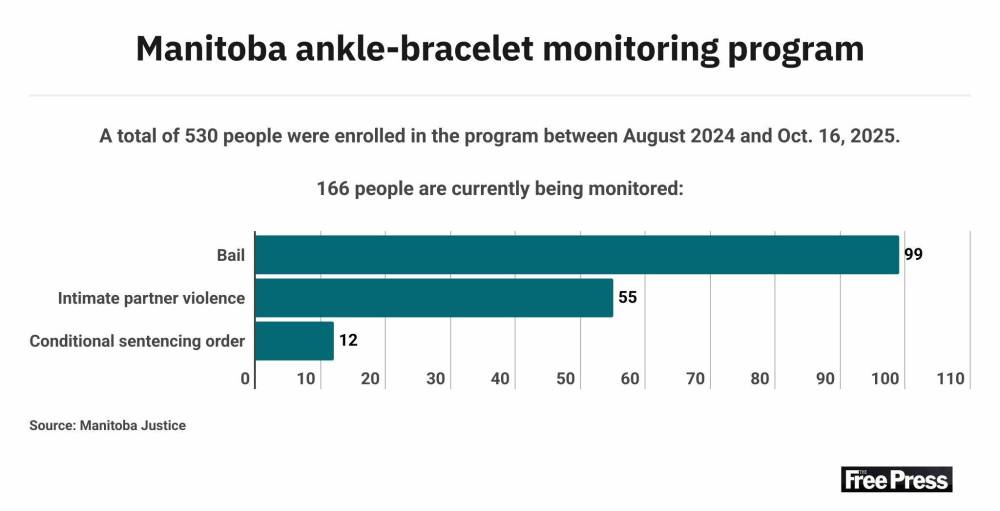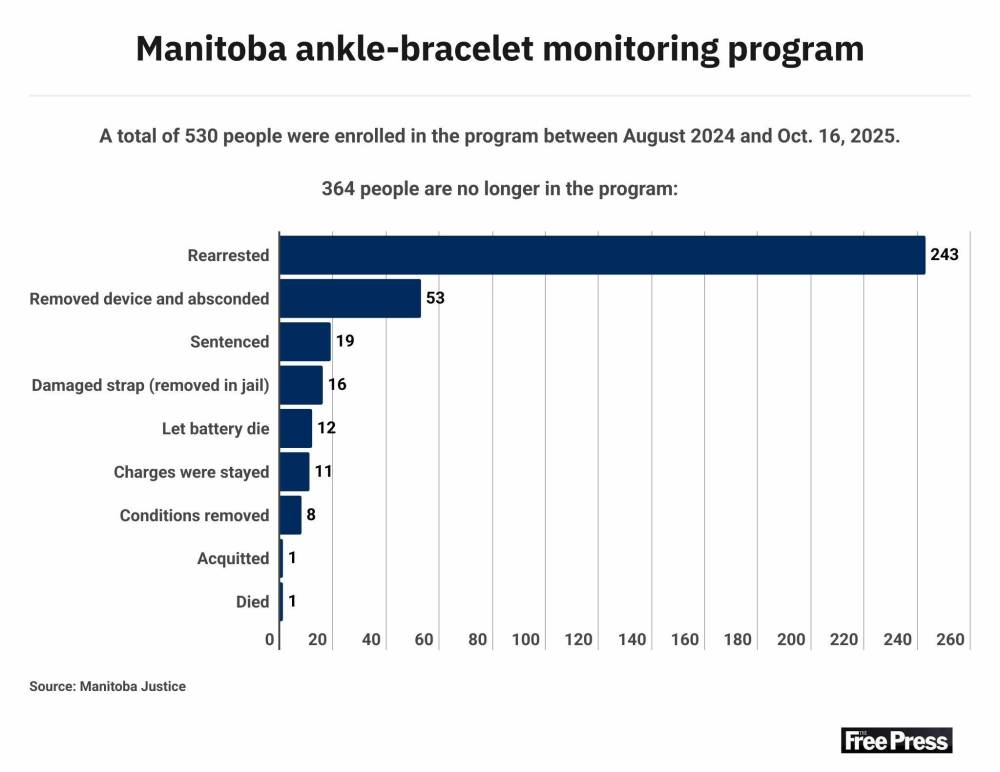‘Significantly high failure rate’
Majority wearing ankle monitors rearrested for breaching conditions or committing additional crimes, data show
Advertisement
Read this article for free:
or
Already have an account? Log in here »
To continue reading, please subscribe:
Monthly Digital Subscription
$0 for the first 4 weeks*
- Enjoy unlimited reading on winnipegfreepress.com
- Read the E-Edition, our digital replica newspaper
- Access News Break, our award-winning app
- Play interactive puzzles
*No charge for 4 weeks then price increases to the regular rate of $19.00 plus GST every four weeks. Offer available to new and qualified returning subscribers only. Cancel any time.
Monthly Digital Subscription
$4.75/week*
- Enjoy unlimited reading on winnipegfreepress.com
- Read the E-Edition, our digital replica newspaper
- Access News Break, our award-winning app
- Play interactive puzzles
*Billed as $19 plus GST every four weeks. Cancel any time.
To continue reading, please subscribe:
Add Free Press access to your Brandon Sun subscription for only an additional
$1 for the first 4 weeks*
*Your next subscription payment will increase by $1.00 and you will be charged $16.99 plus GST for four weeks. After four weeks, your payment will increase to $23.99 plus GST every four weeks.
Read unlimited articles for free today:
or
Already have an account? Log in here »
More than 60 per cent of alleged offenders released with ankle monitors have been rearrested or breached release conditions since Manitoba relaunched the program in August 2024.
New figures released by the province show 530 people had enrolled in the program as of Oct. 16. Of those, 243 were rearrested for violating conditions or committing new crimes. Another 53 removed their monitors and fled, while 16 people damaged the device and 12 others let the battery die.
While the numbers indicate 61 per cent of people enrolled in the program have not complied with their release conditions, Premier Wab Kinew argued the devices are providing enhanced oversight.

There were 530 people enrolled in Manitoba’s ankle-monitoring program as of Oct. 16. (Matt Goerzen/The Brandon Sun files)
“The point is, if somebody is running around when they’re not supposed to, you go arrest them,” Kinew told reporters Monday.
“There’s a deterrence component, but, yeah, if somebody is breaching bail, you should go arrest them. It’s pretty straightforward, I think.”
The devices feature GPS technology and allow law enforcement to track a person’s location. They use audio and vibration commands, and issue loud alerts if a person enters a location they’re barred from visiting.
Probation services, the Crown prosecutions office and police enforce the program, while security company Commissionaires Manitoba monitors it under the province’s authority.
Since the program launched, eight people have had their monitoring conditions removed, while 19 were sentenced and 11 had their charges stayed; one person was acquitted and another died while wearing the device, the province said.
According to the latest figures, 166 people were wearing ankle monitors in October.
Provincial and law enforcement officials have lauded the devices as a means to crack down on repeat offenders and ensure they comply with release conditions, but University of Winnipeg criminal justice Prof. Michael Weinrath said the data show otherwise.
“That’s a significantly high failure rate,” he said.
“I don’t really understand how you can interpret that as a success. All you’re showing is that electronic monitoring is not a very effective deterrent.”
Weinrath said electronic monitoring programs have existed for decades, and critics have long questioned their efficacy.
Manitoba’s support of the program aligns with that of some other provinces in Canada, which have also leaned in on the devices amid a national debate over crime and bail reform, he said.

“It’s always been attractive to politicians because it’s technology and it’s sexy and it gives this idea that we’re protected. But, historically, the research has not been very supportive of electronic monitoring. It doesn’t really prevent re-offence.”
Criminal defence lawyer Chris Gamby said deterrence is only one component of electronic monitoring.
“That’s one way of looking at it, and maybe an idealized version of looking at it. The reality is, though, people can and will sometimes breach their bail,” he said.
“Many times, if someone was on release (without an ankle monitor), it might be possible that they could be in contravention of their order without anybody actually knowing about it.”
Electronic monitoring is typically recommended for people who have a history of violating release conditions or have other aggravating factors requiring additional oversight, he said.
Gamby stressed the devices should not be viewed as a “magic bullet” that will stop all people from re-offending.
“I think what it’s saying is that, if you (violate release), we have a higher chance of detecting and locating you,” he said.
“The fact that it is detecting breaches and people are getting arrested, is that actually a sign that it’s working?”
Use of ankle monitors can be particularly effective in cases involving domestic violence because victims can download an application on their mobile phone to alert them if the accused person is nearby, Gamby added.
Of the people enrolled in the program as of October, 55 were accused of domestic violence offences, the province said.

The Manitoba government initially earmarked $2.9 million for electric monitoring over two years, with Justice Minister Matt Wiebe saying the funding may continue based on its success. He announced another $1.2-million commitment and expanded the program to northern areas in July.
A previous program was scrapped by the former Progressive Conservative government in 2017. Former premier Heather Stefanson — who was then the justice minister — called the monitors inaccurate and ineffective.
The Tories pledged to renew the program in the spring of 2023, before they lost the provincial election that fall.
The NDP then moved ahead with the plan.
The $4.1 million pledged toward the program would be better used to bolster support for housing, addictions and mental health supports that address root causes of crime, Weinrath said.
— with files from Carol Sanders
tyler.searle@freepress.mb.ca

Tyler Searle is a multimedia producer who writes for the Free Press’s city desk. A graduate of Red River College Polytechnic’s creative communications program, he wrote for the Stonewall Teulon Tribune, Selkirk Record and Express Weekly News before joining the paper in 2022. Read more about Tyler.
Every piece of reporting Tyler produces is reviewed by an editing team before it is posted online or published in print — part of the Free Press‘s tradition, since 1872, of producing reliable independent journalism. Read more about Free Press’s history and mandate, and learn how our newsroom operates.
Our newsroom depends on a growing audience of readers to power our journalism. If you are not a paid reader, please consider becoming a subscriber.
Our newsroom depends on its audience of readers to power our journalism. Thank you for your support.






